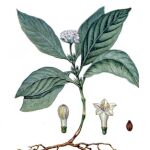| Common Name: |
Ipecac |
| Other Names: |
Ipecacuahna |
| Botanical Name: |
Caphaelis ipecacuanha |
| Genus: |
Caphaelis |
| Family: |
Rubiaceae |
| Native Location: |
Brazil and C America |
| Cultivation: |
Well-drained, rich soil in shade, with ample moisture and humidity. Difficult to cultivate outside its natural habitat. |
| Propagation: |
By greenwood cuttings in late spring, in sandy soil mix at 21-24°C (70-75°F); by root cuttings during harvesting. |
| Harvest: |
Roots are dug when the plants are in flower and dried for use by the pharmaceutical industry. Cultivated plants are replanted after partial removal of roots. |
| Height: |
30-50cm (12-20in) |
| Width: |
30-50cm (12-20in) |
| Hardiness: |
Min. 15-18°C (59-64°F) |
| Parts Used: |
Roots |
| Properties: |
A violent irritant that stimulates the gastric bronchial systems, lowers fevers, and prevents cyst formation in amebic dysentery. |
| Medicinal Uses: |
Internally for coughs, bronchitis, whooping cough, and amebic dysentery. Also used in a syrup to induce vomiting in drug overdoses, and in children who have swallowed poisons, being preferable to the used of a stomach pump for the very young. Excess causes severe vomiting and diarrhea, and may prove fatal. Used in homeopathy for nausea. For use by qualified practioners only. For use strictly according to instructions in commercial medicines. |
| Bibliography: |
Encylopedia of Herbs by Deni Brown Copyright ©: 1995, 2001 Dorling Kindersley Limited pg 163
|

